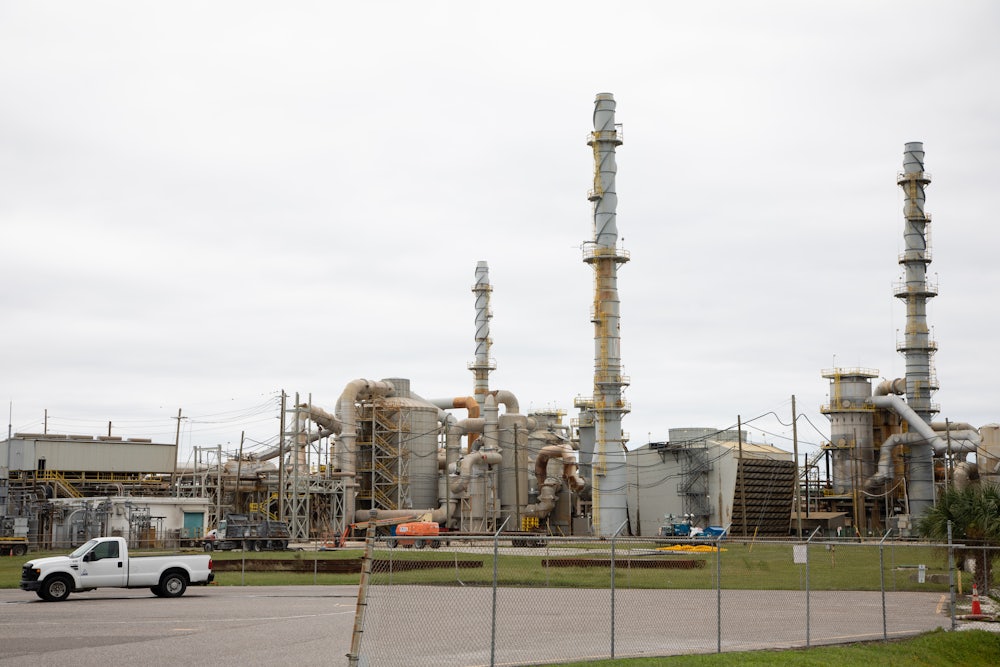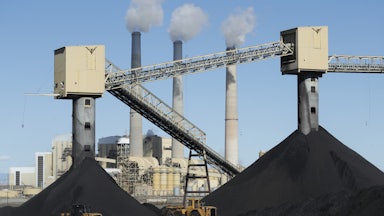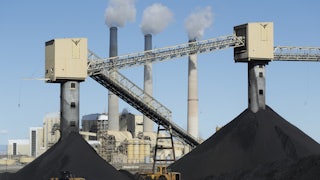“Can we help our economy and our environment at the same time?” a press release from the Phosphate Innovation Initiative recently asked. “Yes! Florida lawmakers recently proved it by joining noted scientists in supporting [phosphogypsum] reuse, an important step toward creating a more circular and sustainable economy, where byproducts are recycled to create new products.”
Incredibly, the cheery, eco-friendly language of this press release is talking not about a benign industry by-product but a radioactive waste material that’s been banned by the Environmental Protection Agency for use in construction. Now Florida lawmakers want to try out using it to make roads—despite a recent accident that released toxic liquid into waterways.
At the end of June, Governor Ron DeSantis signed into law House Bill 1191, approving a study from the Florida Department of Transportation on the use of waste from phosphate-based fertilizer production for road construction. The agency has until April to complete the study. As the bill notes, the final decision on road use of the waste lies with the U.S. EPA.
Supporters of the study say it’s a new recycling stream for the industry’s toxic waste. Critics, meanwhile, say it could create “radioactive roads”—and lead other states to do the same.
Approval of the study is good news for the phosphate industry, which has a big waste problem. Every ton of phosphoric acid produced for fertilizer creates more than five tons of waste, a substance known as phosphogypsum.
Phosphogypsum is not exactly a harmless by-product, according to the EPA. The phosphate ore mined to produce phosphoric acid contains uranium and radium; those radioactive components are concentrated during the manufacturing process. Uranium’s radioactivity is well known. Radium, meanwhile, decays into an odorless, colorless gas called radon, which has been linked to lung cancer—usually after repeated exposure indoors, according to the EPA.
In the 1980s, phosphogypsum was mixed into cement for road building. But in 1992, after studying the issue, the EPA relegated it to large stacks, where it could be properly managed and regulated. (It was also used in concrete and cement before the state of Idaho banned its use in habitable construction in 1977.) Today, more than 70 stacks of phosphogypsum exist across the country. The highest concentration is in central and western Florida, where 24 stacks tower hundreds of feet over the flat landscape. It’s estimated the state contains one billion tons of this waste; 30 million tons are produced each year in Florida alone.
It’s understandable why the phosphate industry would want to hide its waste. The stacks in their current forms, which sometimes act as tall, watered-down ponds for the radioactive material, are liabilities. In 2021, a leak was discovered at the Piney Point phosphate plant in west Florida. More than 300 homes near the wastewater reservoir were evacuated, and Governor DeSantis declared a state of emergency. To avert a greater disaster, 215 million gallons of the toxic liquid were discharged into Tampa Bay.
A study from last year found the discharge released a year’s worth of nutrients in 10 days. Those nutrients provided fuel for the algae that create red tides and kill marine life. Another study from this year found the polluted water flowed out into the Gulf of Mexico—much farther than estimates at the time had shown.
Critics of the new bill say that Florida’s susceptibility to destructive storms and rising sea levels—which will only increase with intensifying climate change—makes roads constructed of phosphogypsum especially concerning. Roads collapsed into the ocean and into inland waterways during Hurricane Ian last year, while government analyses have found that miles of highway are at risk from sea level rise.
“It’s been two years since the Piney Point leak into Tampa Bay, and our water quality is still reeling,” said Ragan Whitlock, a staff attorney with the Center for Biological Diversity’s Florida program. He told me that using this waste in roads is “another possible way for that toxic waste to reenter our bays and waterways.”
It’s puzzling why lawmakers would want to use the same stuff that caused an emergency in 2021 as a material in making roads. But the country’s largest phosphate fertilizer producer, the Mosaic Company, has made powerful allies in the Florida legislature—which may have helped get this bill passed. The primary sponsor of H.B. 1191, Representative Lawrence McClure, is a Republican representing a phosphate-mining-heavy area east of Tampa; he owns $6,000 in Mosaic stock. And last year, the company spent $20,000 on an event for state lawmakers, according to an investigation by the Tampa Bay Times.
The language in the legislation allows for a study of phosphogypsum’s feasibility as a construction material. It says the legislature “declares it to be in the public interest to find alternative ways to use certain recyclable materials that currently are part of the solid waste stream.” It also notes that once the material is deemed suitable and the EPA approves it, companies can go ahead with its use.
“We’re thankful the state sees the value in following the science so that we can all learn more about the beneficial reuse of phosphogypsum,” Jackie Barron, a spokesperson for Mosaic, told me in response to a request for comment on the passage of the bill and on the environmental concerns surrounding the use of its product in roads. Barron said that critics have engaged in “scare tactics” to mischaracterize the Florida study.
Matt Rota, senior policy director for the New Orleans–based organization Healthy Gulf, told me he believes Mosaic and other phosphate-mining companies are trying to greenwash the bill with their use of words like “recycle” to describe the process. “This is not the recycling of radioactive waste,” he said. “This is a way to hide it and dispose of it in an unsafe manner, spreading out exposure throughout the state and throughout the country.”
The nine-month window for the state to complete its study is unlikely to yield any new results about long-term detrimental effects, Rota said—those effects have already been well documented by the federal government, and less than a year isn’t a lot of time to dig up new information on a subject that has already been so thoroughly studied. In past studies, the EPA has raised concerns that roads could leach the hazardous material into groundwater over decades, not just in Florida but in other states with large concentrations of phosphogypsum stacks, such as Idaho. Mosaic also operates in Louisiana, another hurricane-prone state where stacks are prevalent.
Florida lawmakers say the sole focus of their study is to analyze phosphogypsum’s suitability for road construction. An amendment that would have allowed the state Department of Transportation to coordinate with the Department of Environmental Protection and Department of Health to study the potential effects on “human health and the environment” was struck down, meaning that DOT will be the only agency looking into the idea.
The EPA under the Biden administration has been skeptical of phosphogypsum’s use in roads. But Rota is concerned the phosphate industry’s greenwashing and Florida’s study results could convince an environmentally minded president that companies really are looking to recycle their own waste.
The issue has, in the past, shifted with presidents. In 2020, the Trump EPA approved phosphogypsum’s use in road projects. Groups including Healthy Gulf, Sierra Club, and North America’s Building Trade Unions filed a petition in court to rescind the rule. The decision was eventually reversed by the Biden administration in 2021.
Environmental groups say using phosphogypsum in roads is unlikely to significantly decrease the amount of waste in Florida, given the massive quantities around the state. But phosphogypsum mixing in road construction has another upside for the industry. At the moment, the toxic material has little market value and is a P.R. liability in the event of a disaster, as the industry saw with Piney Point. But Whitlock says this new workaround could provide “another revenue stream for Mosaic and other major players in the phosphate industry.”
Mosaic contends that the U.S. is falling behind global trends. It says more than 20 countries around the world, including Canada, already use phosphogypsum in infrastructure. And the industry is quick to point out that the uranium and radium in phosphate ore are known as naturally occurring radioactive materials, or NORM. (To quote the industry-backed Phosphate Innovation Initiative’s website, “NORM is, well … normal!”)
After three decades of strict management under EPA standards, the industry is hoping a study from Florida can revive its campaign to normalize its radioactive waste for other uses. If it succeeds in the Sunshine State, other states could also be convinced that the industry really does want to recycle its waste. Mosaic also mines phosphate in Louisiana. The Canadian fertilizer company Nutrien has operations in six states, including Illinois, Missouri, and North Carolina. J.R. Simplot works in Idaho.
But pretending our only choice is between hulking mountains of toxic material and injection into road projects is a false dichotomy, Rota says.
He notes there’s a third option. “What do we do with it? Well, the first thing we should do is stop producing more of it.”










